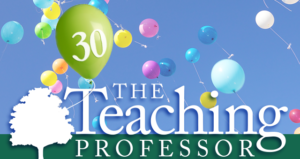
The Teaching Professor Newsletter Celebrates 30 Years
Where were you 30 years ago? Maryellen Weimer, PhD, was writing the very first issue of The Teaching Professor newsletter, and she hasn’t stopped since.
In March 1987, Magna Publications published volume 1, number 1 of The Teaching Professor. The opening article read, in part:
“With all the enthusiasm of a new beginning, Magna begins publication of a newsletter for college professors about college teaching. … Can instruction be improved by reading material about teaching and learning? Yes. Reading about teaching forces reflection. It creates instructional awareness by causing faculty to wonder: Do I do that? Should I do that? Infusing teaching with a steady supply of new ideas keeps it fresh and invigorated.”
That philosophy of reflection and instructional awareness has remained a constant theme throughout the decades. As has the importance of keeping teaching fresh, regardless of teaching experience or discipline.












